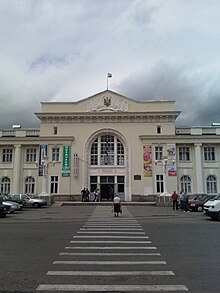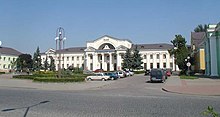Lviv – Stryj – Chop railway line
| Lviv – Stryj – Chop | |||||||||||||||||||||||||||||||||||||||||||||||||||||||||||||||||||||||||||||||||||||||||||||||||||||||||||||||||||||||||||||||||||||||||||||||||||||||||||||||||||||||||||||||||||||||||||||||||||||||||||||||||||||||||||||||||||||||||||||||||||||||||||||||||||||||||||||||||||||||||||||||||||||||||||||||||||||||||||||||||||||||||||||||||||||||||||||||||||||||||||||||||||||||||||||||||||||||||||||||||||||||||||||||||||||||||||||||||||||||||||||||||||||||||||||||||||||||||||||||||||||||||
|---|---|---|---|---|---|---|---|---|---|---|---|---|---|---|---|---|---|---|---|---|---|---|---|---|---|---|---|---|---|---|---|---|---|---|---|---|---|---|---|---|---|---|---|---|---|---|---|---|---|---|---|---|---|---|---|---|---|---|---|---|---|---|---|---|---|---|---|---|---|---|---|---|---|---|---|---|---|---|---|---|---|---|---|---|---|---|---|---|---|---|---|---|---|---|---|---|---|---|---|---|---|---|---|---|---|---|---|---|---|---|---|---|---|---|---|---|---|---|---|---|---|---|---|---|---|---|---|---|---|---|---|---|---|---|---|---|---|---|---|---|---|---|---|---|---|---|---|---|---|---|---|---|---|---|---|---|---|---|---|---|---|---|---|---|---|---|---|---|---|---|---|---|---|---|---|---|---|---|---|---|---|---|---|---|---|---|---|---|---|---|---|---|---|---|---|---|---|---|---|---|---|---|---|---|---|---|---|---|---|---|---|---|---|---|---|---|---|---|---|---|---|---|---|---|---|---|---|---|---|---|---|---|---|---|---|---|---|---|---|---|---|---|---|---|---|---|---|---|---|---|---|---|---|---|---|---|---|---|---|---|---|---|---|---|---|---|---|---|---|---|---|---|---|---|---|---|---|---|---|---|---|---|---|---|---|---|---|---|---|---|---|---|---|---|---|---|---|---|---|---|---|---|---|---|---|---|---|---|---|---|---|---|---|---|---|---|---|---|---|---|---|---|---|---|---|---|---|---|---|---|---|---|---|---|---|---|---|---|---|---|---|---|---|---|---|---|---|---|---|---|---|---|---|---|---|---|---|---|---|---|---|---|---|---|---|---|---|---|---|---|---|---|---|---|---|---|---|---|---|---|---|---|---|---|---|---|---|---|---|---|---|---|---|---|---|---|---|---|---|---|---|---|---|---|---|---|---|---|---|---|---|---|---|---|---|---|---|---|---|---|---|---|---|---|---|---|---|---|---|---|---|---|---|---|---|---|---|---|---|---|---|---|---|---|---|---|---|---|---|---|---|---|---|---|---|---|---|---|---|---|---|---|---|---|---|---|---|---|---|---|---|---|---|---|---|---|---|---|---|---|---|---|---|---|---|---|---|---|---|
|
Route in the Carpathian Mountains
| |||||||||||||||||||||||||||||||||||||||||||||||||||||||||||||||||||||||||||||||||||||||||||||||||||||||||||||||||||||||||||||||||||||||||||||||||||||||||||||||||||||||||||||||||||||||||||||||||||||||||||||||||||||||||||||||||||||||||||||||||||||||||||||||||||||||||||||||||||||||||||||||||||||||||||||||||||||||||||||||||||||||||||||||||||||||||||||||||||||||||||||||||||||||||||||||||||||||||||||||||||||||||||||||||||||||||||||||||||||||||||||||||||||||||||||||||||||||||||||||||||||||||
| Route length: | 266 km | ||||||||||||||||||||||||||||||||||||||||||||||||||||||||||||||||||||||||||||||||||||||||||||||||||||||||||||||||||||||||||||||||||||||||||||||||||||||||||||||||||||||||||||||||||||||||||||||||||||||||||||||||||||||||||||||||||||||||||||||||||||||||||||||||||||||||||||||||||||||||||||||||||||||||||||||||||||||||||||||||||||||||||||||||||||||||||||||||||||||||||||||||||||||||||||||||||||||||||||||||||||||||||||||||||||||||||||||||||||||||||||||||||||||||||||||||||||||||||||||||||||||||
| Gauge : | 1520 mm ( Russian gauge ) | ||||||||||||||||||||||||||||||||||||||||||||||||||||||||||||||||||||||||||||||||||||||||||||||||||||||||||||||||||||||||||||||||||||||||||||||||||||||||||||||||||||||||||||||||||||||||||||||||||||||||||||||||||||||||||||||||||||||||||||||||||||||||||||||||||||||||||||||||||||||||||||||||||||||||||||||||||||||||||||||||||||||||||||||||||||||||||||||||||||||||||||||||||||||||||||||||||||||||||||||||||||||||||||||||||||||||||||||||||||||||||||||||||||||||||||||||||||||||||||||||||||||||
| Power system : | 3000 V = | ||||||||||||||||||||||||||||||||||||||||||||||||||||||||||||||||||||||||||||||||||||||||||||||||||||||||||||||||||||||||||||||||||||||||||||||||||||||||||||||||||||||||||||||||||||||||||||||||||||||||||||||||||||||||||||||||||||||||||||||||||||||||||||||||||||||||||||||||||||||||||||||||||||||||||||||||||||||||||||||||||||||||||||||||||||||||||||||||||||||||||||||||||||||||||||||||||||||||||||||||||||||||||||||||||||||||||||||||||||||||||||||||||||||||||||||||||||||||||||||||||||||||
|
|||||||||||||||||||||||||||||||||||||||||||||||||||||||||||||||||||||||||||||||||||||||||||||||||||||||||||||||||||||||||||||||||||||||||||||||||||||||||||||||||||||||||||||||||||||||||||||||||||||||||||||||||||||||||||||||||||||||||||||||||||||||||||||||||||||||||||||||||||||||||||||||||||||||||||||||||||||||||||||||||||||||||||||||||||||||||||||||||||||||||||||||||||||||||||||||||||||||||||||||||||||||||||||||||||||||||||||||||||||||||||||||||||||||||||||||||||||||||||||||||||||||||
The Lviv – Stryj – Chop railway is a main line in Ukraine . It runs from Lemberg , the center of western Ukraine, to the border town of Chop at the border triangle Slovakia-Ukraine- Hungary , where it connects to the Slovakian network ( Čierna nad Tisou ) and the Hungarian network ( Záhony ). As far as Batjowo , the line has a track width of 1,520 mm (Russian broad gauge), the rest of the route is designed with a track loop in both standard gauge (1,435 mm) and broad gauge. The operation is led by the Ukrainian railways , in particular the Lvivska Salisnyzja .
history
The line was established very early as an important connection between the Kingdom of Hungary and the Austrian crown land of Galicia , the concession for a consortium under the Polish prince Calixtus Poniński for the Lemberg railway via Stryj and Skole to the Hungarian border on the Beskid, for connection with the from Munkács there in execution Hungarian line, and a branch line from Stryj via Bolechów, Dolina and Kalusz to Stanislau for connections to the Lemberg-Chernivtsi Railway (today's Stryj – Ivano-Frankivsk ) took place on October 22, 1871. The following year was on February 17, 1872 a stock corporation with the name K. k. priv. Archduke Albrecht-Bahn founded, this took over the construction and operation of the licensed routes. The construction of the 73.5-kilometer-long railway line from Lemberg to Stryj proceeded quickly due to the geographically simple location and was completed on October 16, 1873, but the extension to Beskid and Hungary was initially not pursued further because the planned lines from Hungary were not built and there was no money on the Galician side for further construction.
On April 5, 1887, the construction of the Stryj-Beskid line (79.3 kilometers) with continuation to Munkács was completed under the leadership of the Austrian State Railways . On the border between Galicia and Hungary, the Beskid tunnel was built to cross the Carpathian ridge . The entire route was then made in standard gauge. In 1891 the Archduke Albrecht-Bahn was finally taken over by the Austrian State Railways.
On the Hungarian side, the railway lines were created under the leadership of the private Hungarian Northeast Railway (Magyar Északkeleti Vasút / MÉKV), the Csap – Bátyú– Királyháza line was opened on October 24, 1872, the Bátyú – Munkács line on December 4, 1872. 1890 was the private railway company finally nationalized.
After the end of the First World War , the main part of the railway came under Polish rule (Lemberg-Beskid route) and was now served by the PKP ; the formerly Hungarian part came under Czechoslovak rule and was operated by the ČSD . The routes had the following numbers:
- 277: Košice– Jasiňa - Stanislawów (section Čop – Baťu)
- 281: Baťu - Volovec - Lwów
Due to the occupation of the southern part of Carpathian Ukraine as a result of the First Vienna Arbitration Award by Hungary, the remaining Kolčino-Polish border line was separated from the rest of the route network and could no longer be served. After the connection of the entire Carpathian Ukraine, the Hungarian Railways took over the operation on the former Czechoslovakian lines. Due to the occupation of eastern Poland by the Soviet Union shortly after the start of the Second World War in 1939, the Polish part of the line also came into the possession of the Soviet railways , which immediately began to re-gauge individual lines, but this was reversed after Germany's attack on the Soviet Union in 1941 made and subordinated the routes of the Eastern Railway . The line Lemberg – Stryj – Lawoczne was given the number 534f.
The end of the Second World War brought with it the annexation of both Eastern Poland and Carpathian Ukraine to the Soviet Union, border controls in the Carpathian Mountains fell away and, under the leadership of the Soviet railways, all standard-gauge railways were switched to broad gauge, since then the railway has been in broad gauge .
However, in order not to disrupt the transport of goods from Slovakia to Romania , the route between Tschop and Batjowo (on to Halmeu in Romania) is designed with a four-rail track (broad gauge and standard gauge).
literature
- Hermann Strach (Red.): History of the railways of the Austro-Hungarian monarchy. Vienna / Budapest 1898 ff. (Multi-volume standard work at the time)
Web links
Individual evidence
- ↑ http://alex.onb.ac.at/cgi-content/anno-plus?aid=rgb&date=18710004&seite=00000355
- ↑ - ( Memento of the original from December 20, 2010 in the Internet Archive ) Info: The archive link was inserted automatically and has not yet been checked. Please check the original and archive link according to the instructions and then remove this notice.
- ↑ http://www.parostroj.net/historie/Zeleznice_Slov_P_Rus/Slovensko.htm#1
- ↑ http://www.pkjs.de/bahn/Kursbuch1944/Teil6/534c.jpg



